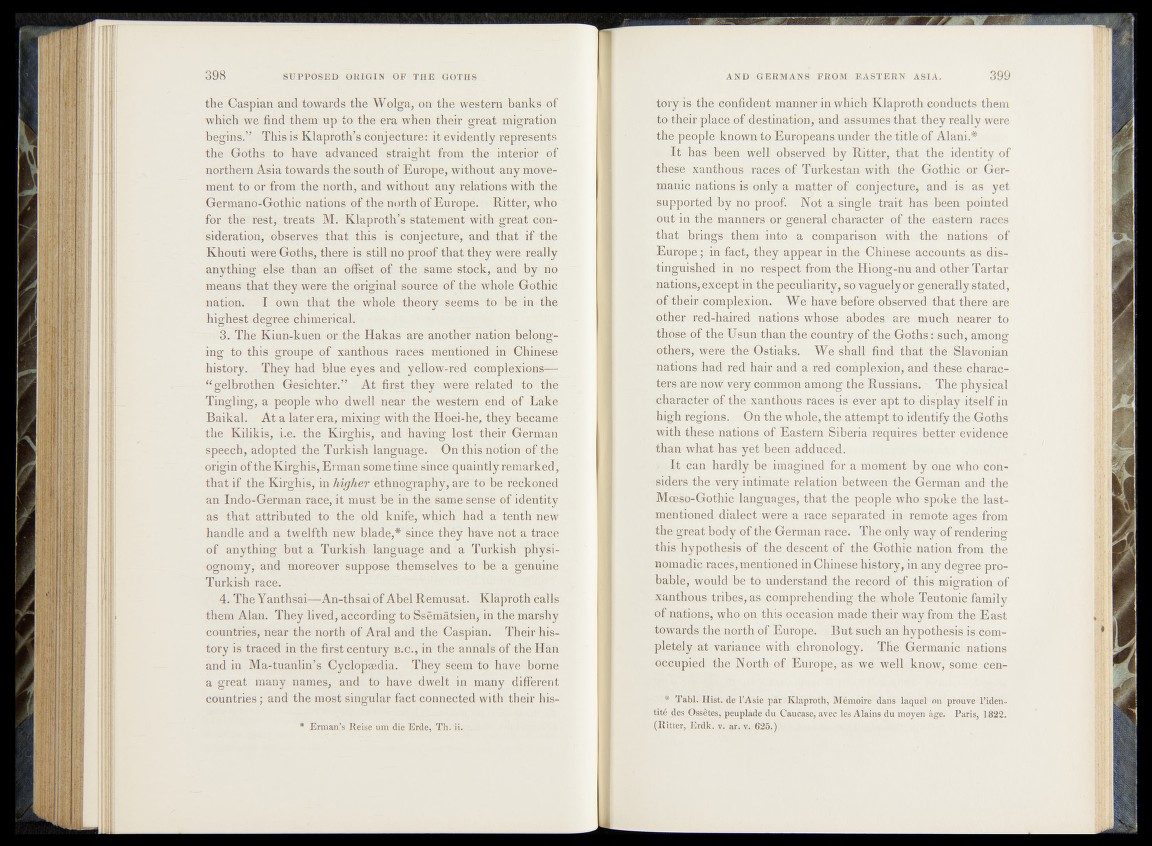
the Caspian and towards the Wolga, on the western banks of
which we find them up to the era when their great migration
begins.” This is Klaproth’s conjecture: it evidently represents
the Goths to have advanced straight from the interior of
northern Asia towards the south of Europe; without any movement
to or from the north, and without any relations with the
Germano-Gothie nations of the north of Europe. Ritter, who
for the rest, treats M. Klaproth’s statement with great consideration,
observes that this is conjecture, and that if the
Khouti were Goths, there is still no proof that they were really
anything else than an offset of the same stock, and by no
means that they were the original source of the whole Gothic
nation. I own that the whole theory seems.,to be'in the
highest degree chimerical.
' '3. .The Kiun-kuen or_the Hakas are another nation belonging
to this groupe of xanthous races mentioned in Chinese
history. They had blue eyes and yellow-reçt Complexionl^-
u gelbrothen Gesiehter.” At first they were* relatée! to the
Tingling, a people who, dwell near the western end of Lakg
Baikal. At a later era, mixingAvith the Hoei-he, they’ became
the Kilikis, i.e. the Kirghis, and having lost theh? German
speech, adopted the TurkishTanguage: On this notion o f the
origin of the Kirghis, Erman sometime since/qudintly remarked,
that if the Kirghis, in higher ethnography, are to be reckoned
an Indo-German race, it must be in the same sensé of identity
as that attributed to the old knife, which had a tenth new
handle and a twelfth new blade,* since théy have not a trace
of anything'but a Turkish language and a Turkish ‘ php|l-
ognomy, and moreover suppose themselves to be a genuine
Turkish race.
4. The Yanthsai—An-thsai of AbelRemusat. Klaproth calls
them Alan. They lived, according to Ssëmâtsien, in the marshy
countries, near th e north of Aral and the Caspian. Their history
is traced in the first century b.c., in the annals of the Han
and in Ma-tuanlin’s Cyclopaedia. They seem to have borne
a great many names, and to have dwelt in many different
countries ; and the most singular fact connected with their his-
Erman.’s Beige urn die Erde, Th. ii.
tory is the confident manner in which Klaproth conducts them
to their place.of destination, and assumes that they really were
the«people known to Europeans under the title of Alani.#
It has been well observed by Ritter, that the identity of
these xanthous races of Turkestan with the Gothic or Germanic
nations is onky.:a matter of conjecture, and is as yet
supported by no pröof. N:ot aisingle trait has been pointed
out in the manners or general character of the eastern races
that brings them into -a comparison with the nations of
Europe;; in fact, they appear in the Chinese accounts as distinguished
inyno respect from the Hicmg-nu and other Tartar
nations, -except in the peculiarity, so vaguely on-gen erally stated,
o f their-complexion. We have- before observed that there are
Other red-haired nations whose abodes4 are .much nearer to
t-hp$e -of the Usun than the country of the Goths : such, among
others, were the Ostiaks..-, We shall find that the /Slavonian
nations had red hair and a red complexion, and these characters
are nov# very common among the Russians'» ' The physical
character of the-xanthous races is ever apt to display itself in
high regions. On the whole, the attempt teèidentify tfie Goths
with these nations of Eastern Siberia requfresrbatter evidence
than what has yet been adduced5./#- ?
* I t Sam; hardly?he imagined foV a moment: by one who considers
the very intimate relation' between the German and the
M.eeso-Gothic languages, that the- peopl-e who spoke the last,-
mentioned dialect were a race separatedpn remote ages from
the great body of the German race'. .The only way of rendering
this hypothesis of-the ^descent of the. Gothic nation from the
nomadic races, mentioned in Chinese history,in anydegree. probable,
would be to understand the- reeord of this migration of Ç i 1
>V, v ' s O . S
xanthous tribes,- as comprehending the whole Teutonic family,
of épiions, who on this occasion made'their way from the East
towards-the north of Europe. But such an hypothesis iseom-
pletely at variance with chronology-. # The Germanic nations
bgcupied the North of Ebfope, as wë well .know, some ce#-
; * Tabl. Hist,«à® TAsie p£r;?l£Mpïoth, Mémoire dans làqdei èb prouve l’ideti-
tlté (les Ossètes, peuplade du Caucase, avec les Alains du moyen âge. Paris, 1822.
(Bitter, Erdk. v. ar. v. 625.)